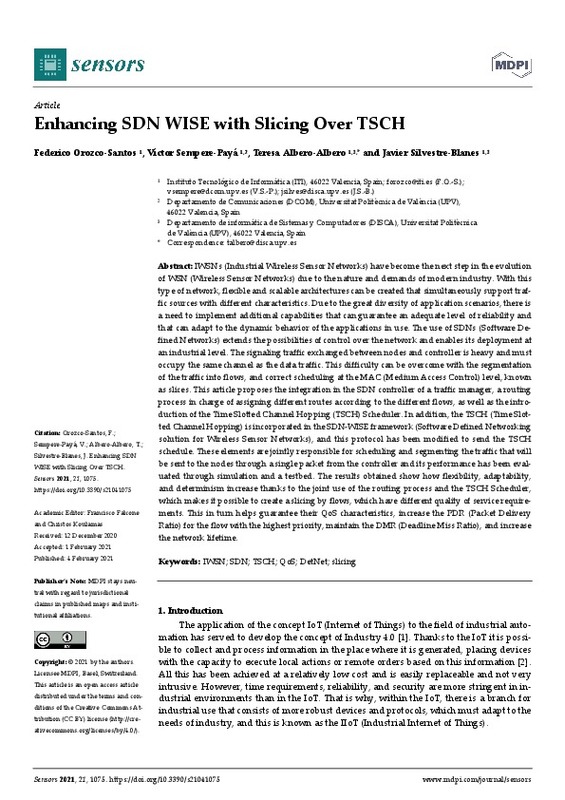|
Resumen:
|
[EN] IWSNs (Industrial Wireless Sensor Networks) have become the next step in the evolution of WSN (Wireless Sensor Networks) due to the nature and demands of modern industry. With this type of network, flexible and scalable ...[+]
[EN] IWSNs (Industrial Wireless Sensor Networks) have become the next step in the evolution of WSN (Wireless Sensor Networks) due to the nature and demands of modern industry. With this type of network, flexible and scalable architectures can be created that simultaneously support traffic sources with different characteristics. Due to the great diversity of application scenarios, there is a need to implement additional capabilities that can guarantee an adequate level of reliability and that can adapt to the dynamic behavior of the applications in use. The use of SDNs (Software Defined Networks) extends the possibilities of control over the network and enables its deployment at an industrial level. The signaling traffic exchanged between nodes and controller is heavy and must occupy the same channel as the data traffic. This difficulty can be overcome with the segmentation of the traffic into flows, and correct scheduling at the MAC (Medium Access Control) level, known as slices. This article proposes the integration in the SDN controller of a traffic manager, a routing process in charge of assigning different routes according to the different flows, as well as the introduction of the Time Slotted Channel Hopping (TSCH) Scheduler. In addition, the TSCH (Time Slotted Channel Hopping) is incorporated in the SDN-WISE framework (Software Defined Networking solution for Wireless Sensor Networks), and this protocol has been modified to send the TSCH schedule. These elements are jointly responsible for scheduling and segmenting the traffic that will be sent to the nodes through a single packet from the controller and its performance has been evaluated through simulation and a testbed. The results obtained show how flexibility, adaptability, and determinism increase thanks to the joint use of the routing process and the TSCH Scheduler, which makes it possible to create a slicing by flows, which have different quality of service requirements. This in turn helps guarantee their QoS characteristics, increase the PDR (Packet Delivery Ratio) for the flow with the highest priority, maintain the DMR (Deadline Miss Ratio), and increase the network lifetime.
[-]
|
|
Agradecimientos:
|
This work has been supported by the MCyU (Spanish Ministry of Science and Universities) under the project ATLAS (PGC2018-094151-B-I00), which is partially funded by AEI, FEDER and EU and has been possible thanks to the ...[+]
This work has been supported by the MCyU (Spanish Ministry of Science and Universities) under the project ATLAS (PGC2018-094151-B-I00), which is partially funded by AEI, FEDER and EU and has been possible thanks to the collaboration of the Instituto Tecnologico de Informatica (ITI) of Valencia.
[-]
|









